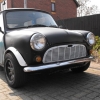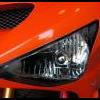
Late Carbed Cooper, Engine Specs?
#1

Posted 20 May 2010 - 11:07 AM
This kinda disagrees with everything else i've read, as the MG Metro engine was supposed to have a high flow, big valve head, and a cam similar to the 266 megadyne, wasn't it??
So my question is, what kinda of head and cam are in my engine??
My engine number is 12A2BG03285123, but the only info i can ascertain from this is that it has a 9.4:1 CR and a 3.1:1 final drive.
#2

Posted 20 May 2010 - 11:45 AM
Source Vehicle : Mini
Engine type & CC : A+ 1275 cc Transverse mounted
Fueling : HIF38 MAC10031, AEM Needle, Red Spring
Engine features :
9.4:1 Compression Ratio
Servo Assisted Brakes
95 Ron Unleaded petrol
Open Loop Catalyst
Pre-engaged starter
Gearbox features :
Std. Ratio Rod Change gearbox with Pot Joints
3.105:1 Final Drive
Thats all I can help with, others will be able to assist you with more info.
#3

Posted 20 May 2010 - 12:08 PM
Using guessworks it says;
Source Vehicle : Mini
Engine type & CC : A+ 1275 cc Transverse mounted
Fueling : HIF38 MAC10031, AEM Needle, Red Spring
Engine features :
9.4:1 Compression Ratio
Servo Assisted Brakes
95 Ron Unleaded petrol
Open Loop Catalyst
Pre-engaged starter
Gearbox features :
Std. Ratio Rod Change gearbox with Pot Joints
3.105:1 Final Drive
Thats all I can help with, others will be able to assist you with more info.
Yeah, that's what i'd already looked on, doesn't say anything about valve sizes or cam...
And i'm hoping that the HIF38 bit is a misprint, because 1275s should have a HIF44 on
Might go and measure the throat size of the carb...
#4

Posted 20 May 2010 - 12:33 PM
The bigger valve head from the MG Metro was lost to a standard one when they had unleaded seats fitted for unleaded petrol. The later MG Metros had this head as well.
Edited by minimanclive, 20 May 2010 - 12:35 PM.
#5

Posted 20 May 2010 - 01:27 PM
The cams are something of an unknown. The MG Metro had its own cam which is really good, but the '90 - '91 carb Coopers had 'who knows what'. I did hear that as Rover were so slow in paying their suppliers they fitted whatever cams they had on the shelf. The quoted power was down on the MG Metro.
I did rebuild one for competition and 'blueprinted' the engine (standard engine was mandated) with an MG Metro cam and head, cleaned up the head and slightly cleaned up the alloy inlet manifold. With a twin-box RC40 exhaust system, but a standard 2-pipe exhaust manifold it gave 94 bhp at the flywheel. I fitted an Aldon distributor and changed the diff ratio to 3.44:1. It went extremely well. The carb was a HIF44 as standard.
#6

Posted 20 May 2010 - 03:38 PM
The heads on those cars had 33.5 mm inlet valves unlike the MG Metro which had 35.6 mm.
The cams are something of an unknown. The MG Metro had its own cam which is really good, but the '90 - '91 carb Coopers had 'who knows what'. I did hear that as Rover were so slow in paying their suppliers they fitted whatever cams they had on the shelf. The quoted power was down on the MG Metro.
I did rebuild one for competition and 'blueprinted' the engine (standard engine was mandated) with an MG Metro cam and head, cleaned up the head and slightly cleaned up the alloy inlet manifold. With a twin-box RC40 exhaust system, but a standard 2-pipe exhaust manifold it gave 94 bhp at the flywheel. I fitted an Aldon distributor and changed the diff ratio to 3.44:1. It went extremely well. The carb was a HIF44 as standard.
My only question is, what does "blueprinted" mean in this context??
Otherwise, that sounds like just what i'm looking to do with my engine, except i'm still stuck between the MG Metro cam and the 276. Aaaand mine'll have megajolt. But the "cleaning up" of the manifold, head, and ports, sounds spot on
Also, from that era of cams, what can i expect mine to have?
#7

Posted 20 May 2010 - 04:30 PM
The service manual says that the head can be skimmed to ensure flatness. You do this enough to give the compression ratio you want, in my case I went for 10.5:1.
In the head chambers, the surface finish is very rough, so you smooth that out and take away the little ridges around the unleaded valve seats.
With the inlet manifold you clean out the casting 'flash' to give a smooth surface but without making the size of the tracts any different.
Then you have the distributor re-curved to give an acurate and optimised advance curve across the rev range.
In the end you have a much better engine which is still, technically, standard and to the original manufaturer's drawings.
Ultimate Blueprinting also means that all components are selected from batches, so that you choose the cam which has the most lift and the most accurate lobe positions. You pick a crankshaft which has accurate throws as close to each other as possible and with no bend in the crank. To do that you need a huge stock of parts so no-one an really do that anymore.
I hope that explains it.
#8

Posted 21 May 2010 - 12:47 PM
That sounds pretty good, and is all pretty doable, just taking away all of the compromises that mass manufacturing has to make...
Cheers for all the replies people!
#9

Posted 21 May 2010 - 08:44 PM
1 user(s) are reading this topic
0 members, 1 guests, 0 anonymous users

















